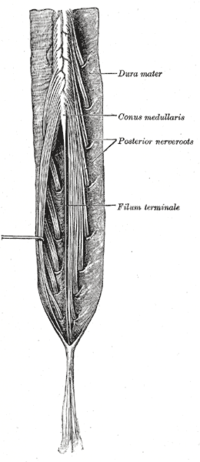
Photo from wikipedia
BACKGROUND CONTEXT Decompression or sequestrectomy in the lumbar spine can be performed under general (GA) or regional anesthesia. In elderly patients, it is still not clear, which procedure should be… Click to show full abstract
BACKGROUND CONTEXT Decompression or sequestrectomy in the lumbar spine can be performed under general (GA) or regional anesthesia. In elderly patients, it is still not clear, which procedure should be chosen. OBJECTIVE To demonstrate that spinal anesthesia (SA) is a safe choice for lumbar decompression or sequestrectomy in elderly patients. DESIGN Retrospective clinical single-center study. PATIENTS SAMPLE We included 154 patients with ages over 75 years after lumbar decompression or sequestrectomy. The mean age of the patients was 81 years. OUTCOME MEASURES Perioperative data (blood loss, dural tear, operative and perioperative time, delirium, urinary retention, and hospital stay) and the postoperative 1-year follow-up (visual analog scale and complication rate). PATIENTS AND METHODS Data were retrospectively collected from patients that underwent lumbar decompression or sequestrectomy between January 2019 and December 2020. The data from the GA and SA groups were compared. RESULTS SA was performed in 56 patients whereas 98 patients received a GA. There was no clinically relevant difference between both groups with comparable complication rates. The time of surgery, blood loss, perioperative time, and hospital stay time were significantly less in the SA group. CONCLUSIONS SA and GA are both safe and reliable procedures for lumbar decompression or sequestrectomy in elderly patients with no clinically relevant difference.
Journal Title: Clinical spine surgery
Year Published: 2023
Link to full text (if available)
Share on Social Media: Sign Up to like & get
recommendations!